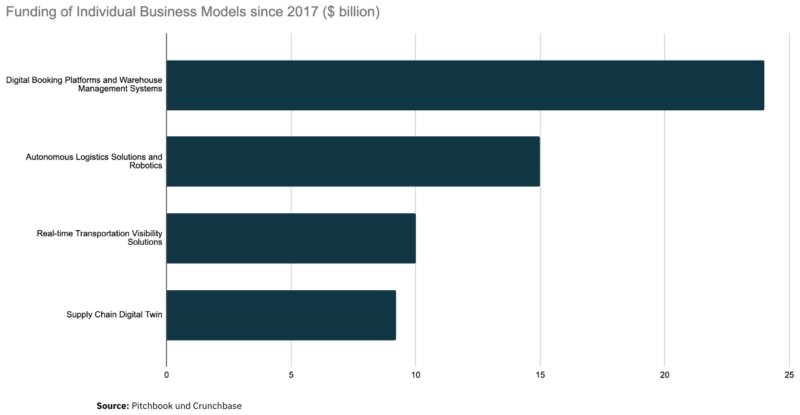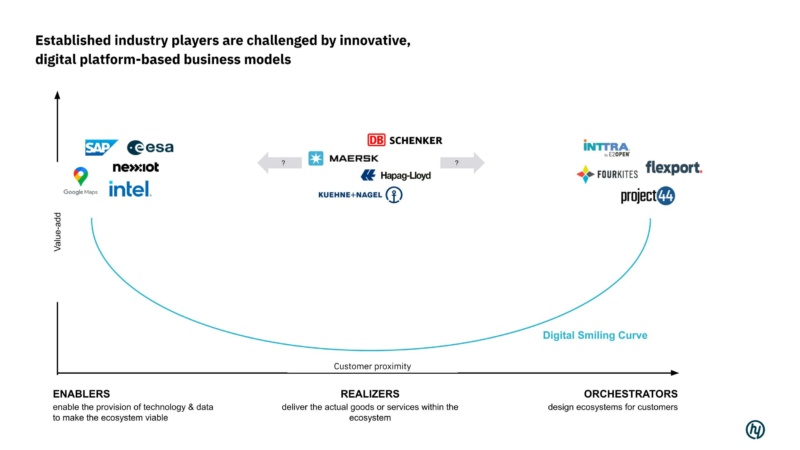Development of Digital Business Models in the Logistics Industry

The logistics industry, once characterized by traditional business models and manual processes, is now at the forefront of digital transformation. Driven by ongoing cost pressures, growing sustainability requirements, and technological advancements, the sector is increasingly being revolutionized by digital business models. These developments are not only a response to internal industry trends but also to the changing expectations of customers, shaped by the digitalization of other areas of life.
Innovative technologies such as artificial intelligence, blockchain, and the Internet of Things (IoT) are becoming standard, enabling logistics companies to make their processes more efficient, transparent, and customer-centric. However, the introduction of these technologies also presents a challenge: it requires companies not only to invest financially but also to rethink their corporate culture and business models.
At hy, we have been contributing to the digital transformation in various industries for years. Below, we describe our experiences from the logistics industry, highlighting current trends and their impact on companies. We also provide insights into possible solution and innovation strategies that we have already successfully applied to clients.
Innovations in Fulfillment
We all know the scenario: You order a product in a clearly designed online shop, compare different shipping options transparently, and have the option to add additional value-added services, such as express shipping or CO2 compensation for the transport. After ordering, you receive an estimated time of arrival (ETA) accurate to a few hours and the ability to track the current location of the product at any time. Pioneers of this development are e-commerce giants like Amazon and Alibaba, who develop advanced digital solutions and business models.
However, about 90% of all goods were originally shipped by container. Focusing on international logistics and transport, the above-described customer experience is far from reality. Senders and shippers often have no way to compare offers from different providers transparently. There are few digital services, and logistics companies often lack the possibility of a digital buying journey. Even during transport, the actual location of the container is difficult to trace, and ETAs are usually inaccurate.
Start-ups and Technological Innovation
Many traditional logistics companies cannot meet the increased customer expectations. More and more start-ups are entering the market with innovative, digital business models, revolutionizing the industry. These young companies are often more agile, willing to take risks, and strongly technology-oriented, making them serious competitors for traditional logistics service providers.

Our analysis shows a significant increase in start-up funding since 2015, peaking in 2021, followed by a decline in subsequent years. This development is partly due to the economic recovery after the first wave of the COVID-19 crisis. The pandemic accelerated digitalization in many industries, with technologies such as AI, cloud computing, e-commerce, and remote working booming. This increased interest in technology-oriented start-ups. Additionally, start-ups benefited from ample capital availability and an attractive IPO market, creating a favorable investment environment, particularly in the logistics industry, leading to record investments.
Despite consistently solid investment levels, the trend since 2021 indicates a slowdown. Recent global economic uncertainties, including inflation and interest rate changes, have led to a noticeable decline in cash flows. These factors influence the funding landscape, presenting both challenges and opportunities for start-ups and established companies in the logistics industry.

Our analysis of investment priorities shows that digital booking platforms and warehouse management systems have received the most attention. These technologies are crucial for increasing efficiency and transparency in logistics. Autonomous logistics solutions and robotics follow closely, reflecting the trend towards automation. This can reduce operating costs and increase reliability. Real-time visibility Solutions enable tracking the location and condition of shipments at any time. Start-ups in this area have also attracted significant investments. Finally, the digital twin of the supply chain, a digital representation of physical processes, shows potential for precise analysis and optimization.
These investments highlight the industry’s strong focus on digital platforms and automation to meet increased customer expectations and competitive pressure.
Platform-based Business Models
As described, there is an increasing number of platform-based business models. These platforms facilitate booking and coordination across a variety of service providers, enabling greater transparency and cost efficiency.
They have not only changed the way logistical services are offered and demanded but also sustainably influenced market structures.
Although digital platforms have the potential to fundamentally change the logistics industry, they have not yet achieved the same dominance as in B2C markets. This is due to the complexity of the industry, existing traditional structures, and technological challenges. Integrating technologies such as artificial intelligence, blockchain, and the Internet of Things into logistics platforms is both time and resource-intensive.
The success of many new logistics start-ups heavily depends on their ability to use innovative technologies and solve real problems in the supply chain. Efficiency improvements through automation, improved route planning, and the reduction of empty runs are just some of the advantages enabled by these platforms. Start-ups that can offer such solutions can also compete in a highly competitive market.
Connected Supply Chain and Real-time Visibility
The connected supply chain and the associated real-time visibility are crucial developments in the logistics industry. They allow companies to monitor and control the movements of their goods in real time, leading to significant improvements in efficiency and customer satisfaction.
One technological enabler of this trend is the transition from EDI to API. Electronic Data Interchange (EDI) often leads to delays of up to 24 hours in data exchange. The introduction of APIs (Application Programming Interfaces) enables real-time tracking, allowing immediate visibility and faster response times. Additionally, IoT devices are becoming increasingly affordable and available. These devices can be attached to transport means or directly to the goods, enabling seamless location and condition monitoring in real-time.
We generally distinguish between two operational application areas:
Real-Time Transportation Visibility Platforms: Start-ups like Project44 and FourKites offer real-time visibility regardless of the actual logistics performance. They aggregate data from various sources, such as terminals and truck telematics, along the entire logistics chain. They challenge the data sovereignty and data quality of logistics providers and contribute to making traditional logistics service providers increasingly interchangeable. They provide shippers with a complete overview of their goods and increased planning security.
Logistics Companies: More and more innovative companies are equipping their containers and transport means with IoT devices. They create visibility as a premium service for their customers, challenging the business model of real-time transportation visibility platforms. The development towards a connected, transparent, and real-time controllable supply chain is a major driver for digital transformation in the logistics industry.
#hythought:
Transport and logistics companies can enhance their value-add through targeted positioning on the Digital Smiling Curve.
Solutions for Established Companies
In this rapidly changing digital environment, established logistics companies face the challenge of adapting to new market requirements. Here are three strategic approaches traditional logistics companies can take to respond to new challenges:
- Focus on Customer Value in Innovation Activities
Companies should focus on actually improving the customer experience through the use of digital technologies. This includes optimizing user interfaces, personalizing services, and offering self-service options. Services and products must be able to quickly adapt to the changing needs of customers. By offering value-adding services, such as advanced analytics services, supply chain optimization, or sustainability solutions, companies can create additional value.

2. Find a Value-adding Position in the Digital Ecosystem
The Digital Smiling Curve shows that the greatest value is created either by the enablers or the orchestrators. The realizers, the actual service providers, generate less value. Companies should reconsider their positioning within the digital smiling curve, identify the points where they can create the most value, and allocate resources accordingly. It is possible to be successful in all three positions simultaneously.
Partnerships and collaborations with enablers or orchestrators in the ecosystem can help bring innovative solutions to market faster. Additionally, platform strategies can be developed that allow the integration of various products and offer a more comprehensive service.
3. Targeted Use of Technologies
Modern technologies should not only be used as a support function but as the core of the business model. This includes the adoption of AI, IoT, blockchain, and other disruptive technologies to increase efficiency and reduce costs. Companies should be open to technologies developed outside the industry and adapt them to the specific needs of logistics.
These strategic approaches have been successfully established by us at hy with multiple clients. They not only offer traditional logistics companies the opportunity to assert themselves in a digitally transformed market but also actively shape the direction of the industry and act as pioneers in the digital era.
Would you like to learn more about how digital business models are revolutionizing the logistics industry and which strategic approaches are optimal for your company? We are happy to help you identify and implement innovative solutions. Contact us for more information.


